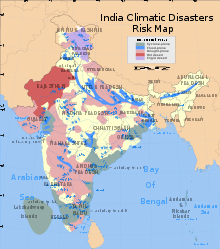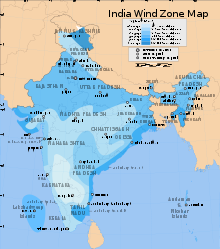Natural disasters in India
This article is written like a personal reflection, personal essay, or argumentative essay that states a Wikipedia editor's personal feelings or presents an original argument about a topic. (May 2013) |
 |
 |
Natural calamities in India, many of them related to the climate of India, cause massive losses of life and property. Droughts, flash floods, cyclones, avalanches, landslides brought by torrential rains, and snowstorms pose the greatest threats. A natural disaster might be caused by earthquakes, flooding, volcanic eruption, landslides, hurricanes etc. In order to be classified as a disaster, it will need to have a profound environmental effect and/or human loss and frequently incurs a financial loss.[1] Other dangers include frequent summer dust storms, which usually track from north to south; they cause extensive property damage in North India[2] and deposit large amounts of dust and dirt from arid regions. Hail is also common in parts of India, causing severe damage to standing crops such as rice and wheat and many more crops and effects many people.
Landslides and avalanches
Landslides are very common in the Lower Himalayas. The young age of the region's hills results in rock formations, which are susceptible to slippages. Rising population and development pressures, particularly from logging and tourism, cause deforestation. The result is denuded hillsides which exacerbate the severity of landslides; since tree, cover impedes the downhill flow of water.[3] Parts of the Western Ghats also suffer from low-intensity landslides. Avalanches occurrences are common in Kashmir, Himachal Pradesh, and Sikkim etc. Landslides in India are also highly dangerous as many Indian families and farmers reside in the hills or mountains.
Floods in India
Floods are the most common natural disaster in India. The heavy southwest monsoon rains cause the Brahmaputra and other rivers to distend their banks, often flooding surrounding areas. Though they provide rice paddy farmers with a largely dependable source of natural irrigation and fertilisation, the floods can kill thousands and displace millions. Excess, erratic, or untimely monsoon rainfall may also wash away or otherwise ruin crops.[4][5] Almost all of India is flood-prone, and extremely precipitation events, such as flash floods and torrential rains, have become increasingly common in central India over the past several decades, coinciding with rising temperatures. Meanwhile, the annual precipitation totals have shown a gradual decline, due to a weakening monsoon circulation[6] as a result of the rapid warming in the Indian Ocean[7] and a reduced land-sea temperature difference. This means that there are more extreme rainfall events intermittent with longer dry spells over central India in the recent decades.
Cyclones in India
The Intertropical Convergence Zone may affect thousands of Indians living in the coastal regions. Tropical cyclogenesis is particularly common in the northern reaches of the Indian Ocean in and around the Bay of Bengal. Cyclones bring with them heavy rains, storm surges, and winds that often cut affected areas off from relief and supplies. In the North Indian Ocean Basin, the cyclone season runs from April to December, with peak activity between May and November.[8] Each year, an average of eight storms with sustained wind speeds greater than 63 kilometres per hour (39 mph) form; of these, two strengthen into true tropical cyclones, which have sustained gusts greater than 117 kilometres per hour (73 mph). On average, a major (Category 3 or higher) cyclone develops every other year.[9][10]
During summer, the Bay of Bengal is subject to intense heating, giving rise to humid and unstable air masses that produce cyclones. Many powerful cyclones, including the 1737 Calcutta cyclone, the 1970 Bhola cyclone, the 1991 Bangladesh cyclone, the 1999 Odisha cyclone, and 2019s Cyclone Fani in Odisha and Cyclone Vayu in Gujarat, have led to widespread devastation along parts of the eastern coast of India and neighboring Bangladesh. Widespread death and property destruction are reported every year in exposed Tamil Nadu, and West Bengal. India's western coast, bordering the more placid Arabian Sea, experiences cyclones only rarely; these mainly strike Gujarat and, less frequently, Kerala and sometimes Odisha.
In terms of damage and loss of life, the 1999 Odisha cyclone, a super cyclone that struck Odisha on 29 October 1999, was the worst in more than a quarter-century. With peak winds of 160 miles per hour (257 km/h), it was the equivalent of a
In terms of damage and asset destruction,
2021 Cyclone Tauktae killed at least 104 people, the highest in a decade.[15]
Climate change impacts on environment
Monsoon
The Indian meteorological department has declared that water cycle will be more intense, with higher annual average rainfall as well increased drought in future years.
Rivers and glaciers
The per capital availability of freshwater in India is expected to drop below 1000 cubic meters by 2025 because of population growth and climate change. River basins of
Glaciers are the main source of water for the Himalayan Rivers such as
Sea level rise
Rise in sea temperature and sea level leads to loss of marine ecosystems and biodiversity, salination, erosion and flooding and also increases occurrence and intensity of storms along entire shoreline. Climate Change impacts are already observed in submergence of coastal lands in the Sundarbans,[22] loss of wetlands[23] and of coral reefs by bleaching,[24] and an estimated sea level rise of 1.06 - 1.75 mm/year.[citation needed]
Low-end scenarios estimate sea levels in Asia will be at least 40 cm higher by 2100. The IPCC calculates that it would expose 13–94 million people to flooding, with about 60% of this total in South Asia. A sea-level rise of 100 cm would inundate 5,763 cubic km of India's landmass.
Droughts, heatwaves and storms
500Mha land in the
Disaster response agencies
- National Disaster Management Authority (India)
- National Disaster Response Force (NDRF), a union force under NDMA
- Odisha Disaster Rapid Action Force (ODRAF)
- State Disaster Response Force (Assam)
- Tamil Nadu State Disaster Management Authority (TNSDMA)
See also
Citations
- S2CID 43711999.
- ^ Balfour 1976, p. 995.
- ^ Allaby 1998, p. 26.
- ^ Allaby 1998, p. 42.
- ^ Allaby 1998, p. 15.
- from the original on 2019-09-01. Retrieved 2019-09-01.
- (PDF) from the original on 2019-09-03. Retrieved 2019-06-29.
- NOAA. Archivedfrom the original on 2006-07-18. Retrieved 2006-07-25.
- ^ Atlantic Oceanographic and Meteorological Laboratory, Hurricane Research Division. "Frequently Asked Questions: When is hurricane season?". National Oceanic and Atmospheric Administration. Archived from the original on July 18, 2006. Retrieved July 25, 2006.
- NOAA. Archivedfrom the original on 2012-07-31. Retrieved 2006-07-25.
- ^ a b c "Tropical Cyclone 05B" (PDF). Naval Maritime Forecast Center (Joint Typhoon Warning Center). Archived from the original (PDF) on 2011-06-07. Retrieved 2007-04-08.
- ^ a b c "1999 Supercyclone of Orissa". BAPS Care International. 2005. Archived from the original on 2007-09-27. Retrieved 2007-04-08.
- ^ a b "2020 Supercyclone Amphhan". The Times of India. 2020. Archived from the original on 2020-06-04. Retrieved 2020-06-05.
- ^ "US Dollar". Archived from the original on 2020-05-22. Retrieved 2020-06-05.
- ^ "Explained: How does Tauktae compare with other cyclones in severity and damage?". The Indian Express. 2021-05-27. Archived from the original on 2021-06-07. Retrieved 2021-09-19.
- ^ a b http://www.indiaenvironmentportal.org.in/files/india-climate-5-water-DEFRA.pdf Archived 2018-07-03 at the Wayback Machine [bare URL PDF]
- ^ Sathaye, Jayant; Shukla, Priyadarshi; H. Ravindranath, N (30 November 2005). "Climate change, sustainable development and India: Global and national concerns". Curr Sci. 90 – via ResearchGate.
- ^ http://www.indiaenvironmentportal.org.in/files/cc10.pdf Archived 2018-07-03 at the Wayback Machine [bare URL PDF]
- ^ "India: Climate Change Impacts". Archived from the original on 2018-07-03. Retrieved 2018-07-03.
- ^ "India will be the hotspot of water crisis by 2025: UN". www.indiawaterportal.org. Archived from the original on 2018-07-03. Retrieved 2018-07-03.
- ^ http://www.saded.in/PDF%20Files/Kulkarni_GW_Effect_HimalayanGlaciers_Shrinkage.pdf Archived 2018-11-23 at the Wayback Machine [bare URL PDF]
- ^ "Sinking Sundarbans islands underline climate crisis". 17 January 2018. Archived from the original on 3 July 2018. Retrieved 3 July 2018.
- S2CID 3807851– via ResearchGate.
- .
- ^ "10.4.3 Coastal and low lying areas – AR4 WGII Chapter 10: Asia". www.ipcc.ch. Archived from the original on 2018-07-03. Retrieved 2018-07-03.
- ^ https://mpra.ub.uni-muenchen.de/22062/1/MPRA_paper_22062.pdf Archived 2017-08-13 at the Wayback Machine [bare URL PDF]
- PMID 28811627.
- ISBN 9780306479809. Archivedfrom the original on 17 January 2023. Retrieved 1 December 2020 – via Google Books.
- ^ "India records its hottest day ever as temperature hits 51C (that's 123.8F)". the Guardian. Agence France-Presse. 20 May 2016. Archived from the original on 23 May 2016. Retrieved 3 July 2018.
- ^ "India's killer heatwaves claim 4620 deaths in last four years". 23 April 2017. Archived from the original on 3 July 2018. Retrieved 3 July 2018.
- ^ "Effects of climate change: If global warming continues, summers in India could last for 8 months by 2070, say researchers – Firstpost". www.firstpost.com. 11 January 2018. Archived from the original on 3 July 2018. Retrieved 3 July 2018.
- ^ "Dust storms may increase in India due to climate change". india.mongabay.com. 2018-05-08. Archived from the original on 2018-07-03. Retrieved 2018-07-03.
- S2CID 26920225.
Further reading
- Toman, MA; Chakravorty, U; Gupta, S (2003). India and Global Climate Change: Perspectives on Economics and Policy from a Developing Country. Resources for the Future Press. ISBN 978-1-891853-61-6.
External links
- General overview
- "Country Guide: India". BBC Weather. Archived from the original on 2005-05-25. Retrieved 2007-11-16.
- "India—Weather and Climate". High Commission of India, London. Archivedfrom the original on 2008-12-01. Retrieved 2007-11-16.
- Reports
- Disaster management in India Archived 2011-10-06 at the Wayback Machine
- Resources on Natural Disasters
- Resources on floods Archived 2011-10-06 at the Wayback Machine
- Resources on Drought Archived 2011-08-27 at the Wayback Machine
- Maps, imagery, and statistics
- "India Meteorological Department". Government of India. Archived from the original on 2014-11-04. Retrieved 2007-11-16.
- "Weather Resource System for India". National Informatics Centre. Archived from the original on 2007-04-29. Retrieved 2007-11-16.
- Forecasts
- "India: Current Weather Conditions". National Oceanic and Atmospheric Administration (NOAA). Archived from the original on 2007-04-25. Retrieved 2007-04-24.
